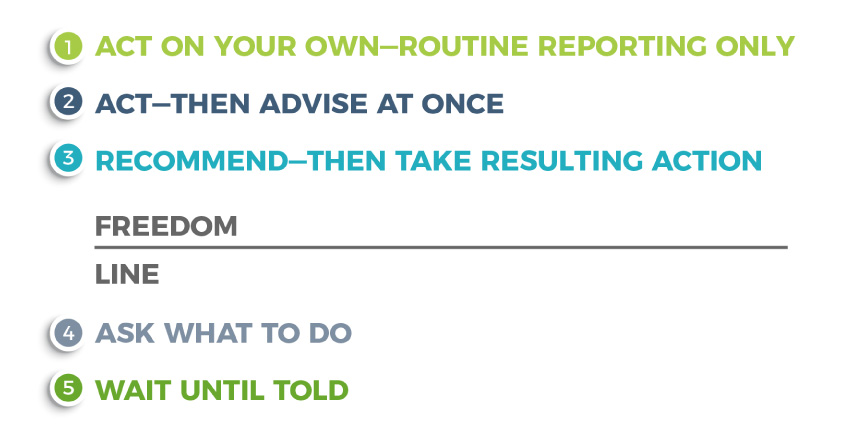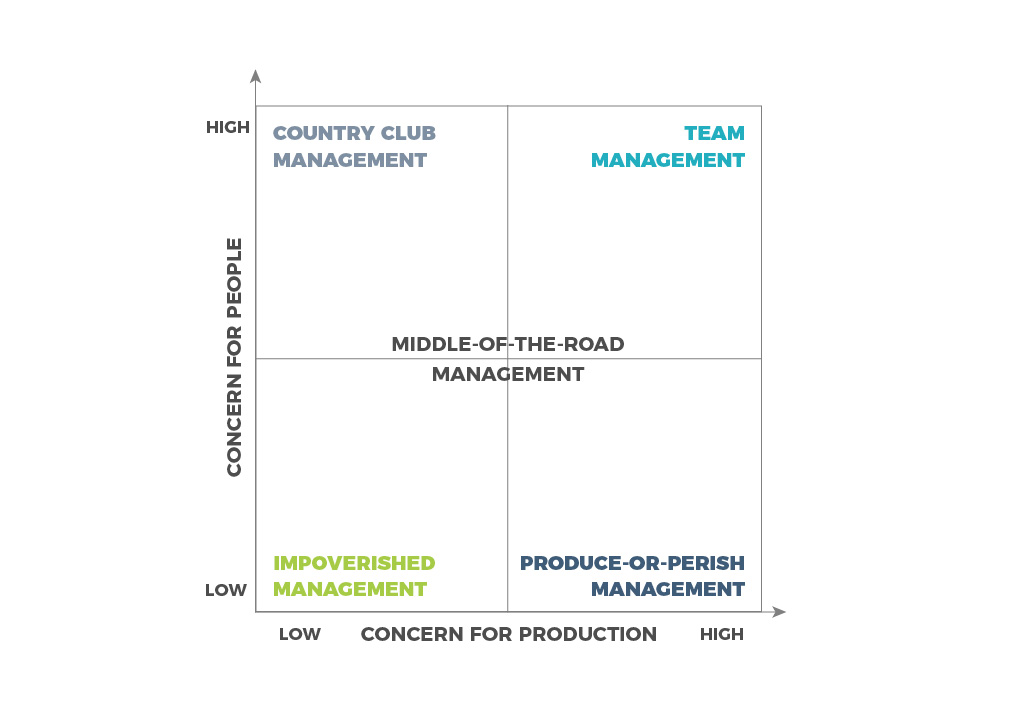
Written by Watershed CI
July 9, 2019
How do you share leadership with others?
The degree of freedom you establish with others will shape your leadership style. It determines the level of control and trust you have in others.
Consider the Freedom Line. The three points above the freedom line indicate ways to lead others to act freely. The first degree is the ultimate level—allowing people to act on their own and report results. Below the freedom you become a slave to others—because they will either ask what to do or even worse wait for you to tell them what to do. This means no freedom to really be your best self and lead with trust, commitment and accountability.
The Five Degrees of Freedom

The Five Degrees of Freedom reminds us to afford freedom to others wherever possible. In the end, when we all do our jobs and interact well together everyone wins.
Do you focus on tasks or people?
The managerial grid model, developed by Robert R. Blake and Jane Mouton in the mid-1960s, has undergone several renovations over the years; however, the grid’s basic premise persists. It measures leadership styles against a predilection for either production or people.

Leaders who favour ‘getting things done’ lean toward production, while those concerned with their team’s wellbeing prefer a people focus—others balance both. Neither is correct. Again, the value of the model is to understand one’s innate leadership qualities, plot them on the grid and then assess any areas needing improvement. The Blake Mouton grid defines five disparate styles:
Country club leadership (high people, low production): Country club leaders focus exclusively on facilitating positive feelings within their workforce.
Produce or perish leadership (low people, high production): In this scenario, the leader views people as a means to an end; production trumps people every time. While things get done; high turnover often occurs and the firm may have difficulty attracting qualified employees.
Impoverished leadership (low people, low production): Leaders employing this style typically prove ineffective. Lack of interest in creating efficient internal systems combined with minimal regard for employees creates disharmony, disorganization and dissatisfaction.
Middle-of-the-road leadership (medium people, medium production): Initially, this approach appears as an ideal compromise. Upon closer inspection, leaders who employ a middle-of-the-road leadership style often generate tepid results.
Team leadership (high people, high production): In the hierarchy of managerial styles, the team leadership approach represents the pinnacle—it stresses production and people needs equally. Importantly, these leaders fully involve the team in the organization’s purpose and determine production needs collectively. The ensuing culture of trust and respect engenders high satisfaction and motivation, which in turns leads to high production. That said, team leadership styles don’t apply in every business context. A business transformation, for example, requires a higher emphasis on people needs.
Maturing your leadership style
Developing leadership style and capabilities takes time, patience and self-reflection. A work in progress! Here are the actions you should take to consciously take your leadership to higher levels.
Identify your preferred style
- Think of situations where you are leading
- How does it fit within the culture of an organization
- How are you using your unique ability? What level of freedom are you giving to others? Where do you fit on Blake Mouton grid.? For each of these questions what is it telling you about who you are and where you fit.
Find areas of improvement to develop your leadership skills
- Consider your current leadership approach
- Look at ways to improve by asking yourself the tough questions. Are you settling for less because it’s easier?
- Identify ways to get skills, experiment in application and be more effective
- Check your performance. Observe when you might be slipping back into old habits.
Put it in context
- Use your self-awareness to determine the most effective style—or combination of styles. Consider the specific type of work, people and culture without compromising who you are and strive to be.
Bottom line
As a leader, it’s impossible to get things done without people—including you! Self-knowledge, self-awareness, the willingness to experiment and the ability to apply different leadership styles to different situations increases the likelihood of success tenfold.
For more information on identifying leadership potential and leadership development, please contact one of our WCI experts.
By Catherine Daw, MBA, CMC, ACC
LeadingfromBehind Inc.
Catherine is a leadership coach and change catalyst focused on helping people realize their potential.


